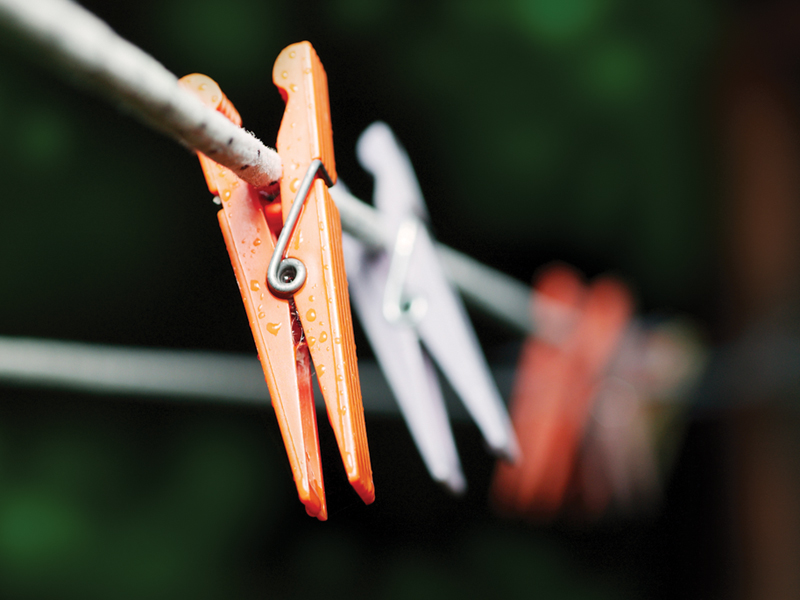Bridget Qualey: Clotheslines
I have no doubt that I gained my love of doing laundry from my mother, more specifically, my love of hanging freshly washed clothes out on the line. I think I've handed that habit and hopefully that love, on to my two daughters.
Every day was laundry day in a household of 11 — nine of those being me and my eight siblings born in the span of just over 10 years. Not all clothes made it to the clothesline, especially in those middle years with everyone still at home. But Saturday was bed changing day, yes, every single Saturday. And I swear no bed sheet ever saw the inside of a dryer drum in my mother's home.
We each had Saturday chores and one of my favorites was hanging clothes on the line. There were various line drying systems over the years. The first one I recall was a multiline "T" ended wooden structure, strung like a giant horizontal harp with strings spaced a foot or so apart.
This clothesline was across the dooryard of our family's first farm in Stacyville, and stood beside a flower garden filled with blooming summer flowers. In those days, Mother had this classic aluminum framed clothes basket. It had scissor-like legs with a light canvas pouch that had envelope-shaped pockets that slid over the rounded tops of the aluminum frame. The whole rig would collapse and fold, making it storable beside the washing machine that sat along the wall next to the cabinets in the busy farm kitchen.
The sheets were folded first in half, and then into quarters as they came out of the washer. The folded sheets were then alternately draped over one side then the other of the cloth covered frame to help balance it side to side to keep the whole thing from falling over. Smaller items were just tossed in the bottom of the canvas pouch to be shaken with a loud snap as they were hung on the line.
The collapsible clothes basket also made it convenient to be lugged under your arm out to the clothesline and where the legs would be spread once again to become free standing, leaving clothes at grabbable height directly under the lines. It still had to be dragged along on its small plastic wheels as shirts and socks were clothes pinned on the line — either that or walk back and forth — as things were hung out to dry.
I remember hanging clothes on that line. I was probably 10 or 11 years old. When I was 13 our sardine packed family left our improvised three bedroom home where the parlor had been turned into our parent's bedroom, with two cribs for the recent baby and just-older toddler. We left our pastoral 100-acre farm overlooking Mount Katahdin and moved eight miles east to a 500-acre farm in Sherman Mills with a big old five-bedroom farm house. There the graceful old elms that lined the driveway and front lawn were strung with line to become the next clothesline iteration needed to dry seven beds’ worth of sheets every Saturday.
But my favorite clothes drying system is a line strung on a set of pulleys. This set up requires a high window or deck as the hanging station with a tree or other anchor about 40-feet away and at least a sheets-length of height off the ground. That length of clothesline will hang about one load of laundry. Once set on a chair or milk crate, your laundry basket never has to move. The empty line comes to you. It is an ideal situation if you can finagle TWO lines so that multiple loads can be done on any given day - weather permitting of course. I'm delighted to report that is the very set up that I have had for the last quarter century here in Camden.
We never had the right situation for a pulley clothesline when I was growing up, but when my parents renovated the house next door to the family farm and a deck was added, my husband and I installed a pulley onto the quaking aspen across their driveway with the other attached to the corner of the house, creating a new clothesline for my mother. Especially in her later years, I think she enjoyed the stationary hanging process. My mother used that clothesline right up until a month or two before she died. I still doubt that she ever dried a bed sheet in a dryer.
With darkness descending in the deeps of winter, I need to collect my wash off the line. Even in winter if the weather comes warm and clear for a day or two my sheets go out to dry. I hope that the clothesline police never descend on Camden. I think my mother's old clothesline will be safe in that regard for years to come up in Aroostook County.
 Bridget Qualey and her family live simply, cooking on a wood burning cookstove for 10 months of the year. She loves using her pulley clothesline off the back deck. She picks fiddleheads in the spring, raspberries in the summer, cans tomatoes in the fall and writes by the fire in the winter.
Bridget Qualey and her family live simply, cooking on a wood burning cookstove for 10 months of the year. She loves using her pulley clothesline off the back deck. She picks fiddleheads in the spring, raspberries in the summer, cans tomatoes in the fall and writes by the fire in the winter.
Transformations
We tell stories.
We tell stories to make sense of our lives.
We tell stories to communicate our experience of being alive.
We tell stories in our own distinct voice. Our own unique rhythm and tonality.
Transformations is a weekly story-telling column. The stories are written by community members who are my students. Our stories are about family, love, loss and good times. We hope to make you laugh and cry. Maybe we will convince you to tell your stories.
— Kathrin Seitz, editor, and Cheryl Durbas, co-editor
"Everyone, when they get quiet, when they become desperately honest with themselves, is capable of uttering profound truths. We all derive from the same source. There is no mystery about the origin of things. We are all part of creation, all kings, all poets, all musicians; we have only to open up, only to discover what is already there." — Henry Miller
Kathrin Seitz teaches Method Writing in Rockport, New York City and Florida. She can be reached at kathrin@kathrinseitz.com. Cheryl Durbas is a freelance personal assistant in the Midcoast area. She can be reached at cheryldurbas@tidewater.net.
Event Date
Address
United States
























